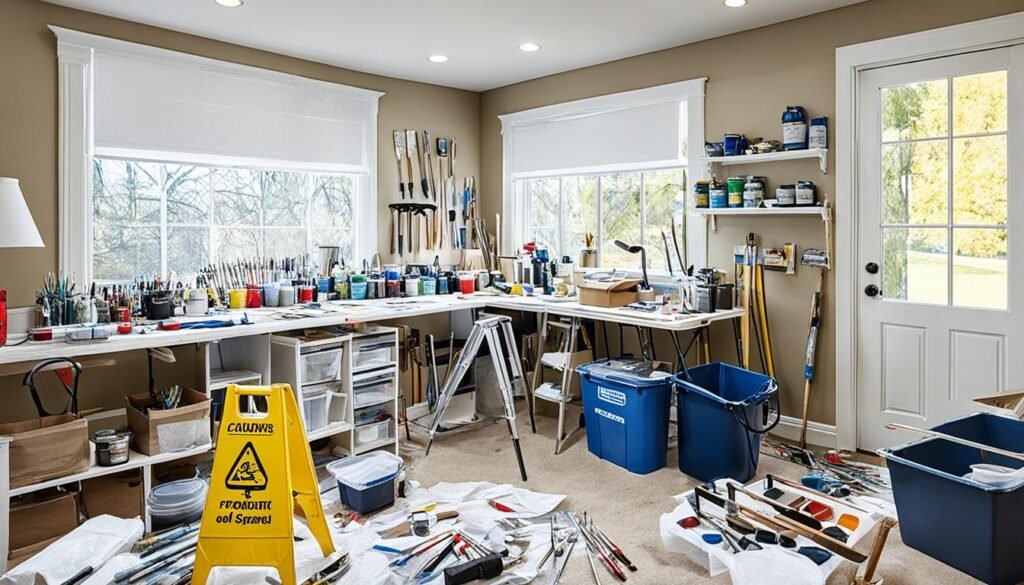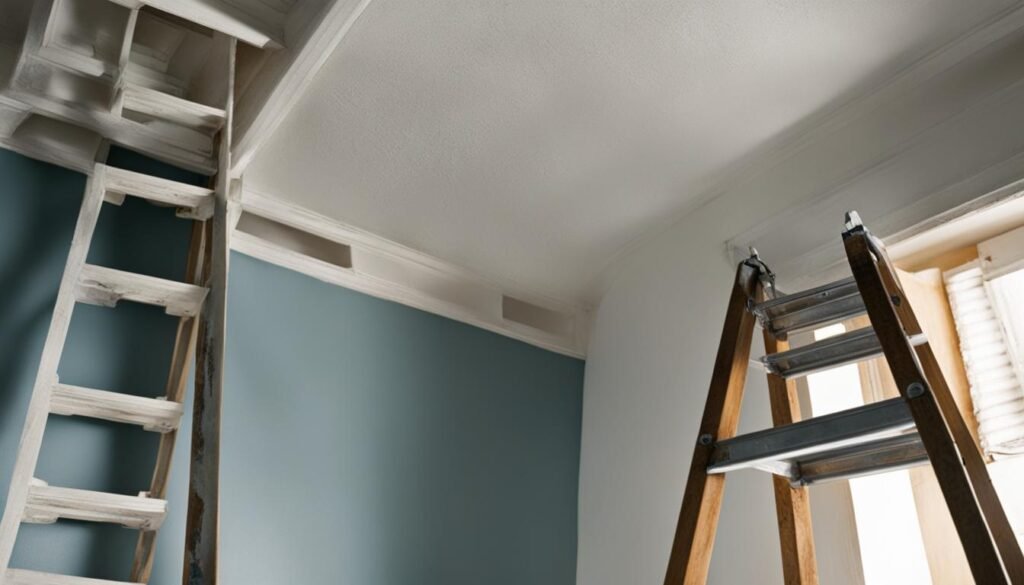Did you know that the average homeowner spends approximately 12 hours painting a single room? That’s a significant amount of time dedicated to achieving a fresh and vibrant look. However, one thing that often deters people from taking on this task is the fear of creating a mess, especially when it comes to painting ceilings.
But fear not! With the right techniques and best practices, you can paint your ceilings without making a mess and achieve professional-looking results. In this article, we will provide you with expert tips and advice to ensure a smooth and hassle-free ceiling painting project.
So, if you’re ready to transform your space and add a touch of freshness to your ceilings, let’s dive into the tips and techniques that will help you paint ceilings like a pro!
Key Takeaways:
- Preparing the room and protecting surfaces is crucial before you start painting.
- Using primer and choosing the right type of paint is essential for a flawless finish.
- Combining a paint brush and roller will help you achieve the best results.
- Applying multiple thin coats of paint ensures better adhesion and less mess.
- With the right tools, patience, and attention to detail, you can transform your ceilings and enhance the overall look of your space.
Preparing the Room and Protecting Surfaces
Before you start painting the ceiling, it’s important to take some necessary steps to prepare the room and protect surfaces. By following these guidelines, you can avoid any accidental spills, protect your floors and furniture, cover light fixtures, and ensure you’re wearing appropriate clothing.
1. Remove Furniture or Cover with Drop Cloths
To prevent any paint splatters on your furniture, it’s best to either remove it from the room entirely or cover it with drop cloths. This will protect your valuable pieces from accidental spills and drips. Make sure the drop cloths are securely placed and cover the furniture entirely.
2. Use Painter's Tape to Cover Light Fixtures
If it’s not possible to remove light fixtures, use painter’s tape to cover them. This will protect them from paint splatters and ensure they remain clean and undamaged during the painting process. Be careful not to use excessive force when applying the tape to avoid any damage to the fixtures.
3. Wear Clothing You Don't Mind Getting Paint On
Painting can be a messy job, and there’s always a chance you might get some paint on your clothes. To avoid ruining your favorite outfit, choose clothing that you don’t mind getting paint on. You can also consider wearing a disposable suit for added protection and ease of cleanup.

Summary
Preparing the room and protecting surfaces before painting the ceiling is crucial to maintaining a clean and hassle-free painting process. By removing furniture or covering it with drop cloths, using painter’s tape to cover light fixtures, and wearing appropriate clothing, you can ensure a smooth and efficient painting experience.
| Benefits of Preparing the Room and Protecting Surfaces: |
|---|
| Prevents accidental spills and paint splatters on furniture |
| Ensures light fixtures remain clean and undamaged |
| Protects floors and carpets from paint drips |
| Keeps you and your clothing safe and clean |
Applying Primer and Paint
When it comes to painting ceilings, applying primer is a crucial step for achieving a smooth and even finish. Primer helps to seal the surface, allowing the paint to adhere properly and ensuring better coverage. Here are some expert tips for applying primer and paint to your ceiling.
Using Primer for Ceilings
Before starting the painting process, choose a high-quality primer specifically designed for ceilings. Look for a primer that offers good adhesion and stain-blocking properties. This will help to cover any existing stains or imperfections on the ceiling, providing a clean and even base for the paint.
Choosing the Right Type of Paint
When it comes to choosing the paint for your ceiling, opt for a high-quality ceiling paint that is specifically formulated for this type of surface. Ceiling paint is designed to have a low splatter and drip-resistant formula, making it easier to work with overhead. Additionally, ceiling paint usually has a flat or matte finish, which helps to minimize the appearance of imperfections.
Brush vs. Roller
When applying primer and paint to your ceiling, it’s best to use a combination of a paint brush and a roller. Start by cutting in the edges and corners of the ceiling with a brush. This will help to ensure that the paint reaches all the nooks and crannies. Then, use a roller to cover the larger areas of the ceiling. A roller will provide a smoother and more even finish compared to a brush.
Applying Multiple Coats
To achieve a flawless finish, it’s recommended to apply multiple thin coats of paint rather than one thick coat. This allows for better adhesion and helps to prevent drips and streaks. Allow each coat to dry completely before applying the next one. Patience is key when it comes to achieving a professional-quality painted ceiling.
By following these tips for applying primer and paint to your ceiling, you can achieve a smooth and even finish that transforms the look of your space. Remember to use high-quality products, take your time, and apply multiple thin coats for the best results.
| Tip | Description |
|---|---|
| Use a high-quality primer | Choose a primer specifically designed for ceilings to ensure proper adhesion and coverage. |
| Select the right ceiling paint | Go for a paint with a low splatter formula and a flat or matte finish to minimize imperfections. |
| Use a combination of brush and roller | Cut in the edges with a brush for precision, then use a roller for smooth and even coverage. |
| Apply multiple thin coats | Avoid thick coats to prevent drips and streaks, and allow each coat to dry before applying the next one. |

Conclusion
Painting a ceiling can be a challenging task, but with the right techniques and tools, you can achieve a flawless finish and keep your space clean throughout the process. By following these professional tips for painting ceilings, you can transform your space and create a beautiful, polished look.
First and foremost, remember to properly prepare the room before you start painting. Cover your furniture and floors with drop cloths to protect them from any accidental spills or drips. Consider using painter’s tape to protect light fixtures and other surfaces that you don’t want to get paint on.
When it comes to painting the ceiling, choose the right tools for the job. A combination of a brush and roller works best for most ceilings. Start by cutting in the edges with a brush, then use the roller to cover the rest of the surface. This will ensure a smooth and even application of paint. Additionally, apply multiple thin coats of paint instead of one thick coat to achieve a flawless finish.
Lastly, don’t forget to prioritize cleanliness throughout the entire process. Clean up any drips or spills immediately to avoid them drying and creating an uneven surface. Use recommended tools for painting ceilings, such as a sturdy ladder or scaffolding, to ensure your safety while reaching high areas.
By following these professional tips for painting ceilings, you can achieve a beautiful finish while keeping your space clean and free from any painting mishaps. With the right preparation, tools, and attention to detail, your ceiling will be a showcase of your painting skills and enhance the overall aesthetics of your space.
FAQ
What are some tips for preparing the room and protecting surfaces before painting the ceiling?
To prepare the room, remove furniture or cover it with drop cloths to prevent spills. Cover or remove light fixtures using painter’s tape. Wear painting-friendly clothing or consider using a disposable suit for added protection.
Why is it important to apply primer before painting a ceiling?
Applying primer is crucial for achieving a smooth and even paint finish on the ceiling. It helps with adhesion and ensures better coverage of the final coat. Choose a high-quality ceiling paint that is specifically designed for this type of surface.
Which tools should I use when painting a ceiling?
For best results, use a combination of a paint brush and a roller. Start by cutting in the edges with a brush, then use the roller to cover the rest of the ceiling. The brush allows for precise control, while the roller ensures a more consistent coat of paint.
How many coats of paint should I apply to the ceiling?
It is recommended to apply multiple thin coats of paint rather than one thick coat. This helps with better adhesion, offers smoother coverage, and minimizes the risk of drips or splatters.
How can I achieve a professional-looking finish while painting a ceiling?
To achieve a professional finish, follow these tips: prepare the room and protect surfaces, use the right type of paint and primer, apply multiple thin coats of paint, and use a combination of a brush and roller for better coverage. Take your time and pay attention to detail.

No comment yet, add your voice below!